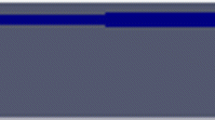Abstract
Periodic liquid waves of large amplitude are one of characteristic phenomena observed in the churn flow regime of gas–liquid flow in vertical conduits, where the liquid flowing on the wall is entrained upwards by the gas flow in the core. The present work investigates the frequency of these large liquid waves. Three-dimensional simulations of isothermal churn flow of air and water in 19 and 32 mm vertical pipes were performed using the interFoam solver from the OpenFOAM library. Turbulent features in the flow are modelled using the unsteady Reynolds Averaged Navier–Stokes approach with the k–ω SST (shear stress transport) model. Interface sharpening with bounded compression was used to preserve the sharpness of gas–liquid interface by compensating the diffusive fluxes of the numerical scheme. A sensitivity study on the global amount of interface compression was performed for two flow cases taken from the literature. Mesh sensitivity study was performed using four meshes, ranging from a coarse mesh with several hundred thousand cells, to a fine mesh with several million computational cells. Results for the calculated wave frequency and wave maximum amplitude agree with measured values reported in the literature.
Similar content being viewed by others
Change history
05 February 2022
A Correction to this paper has been published: https://doi.org/10.1007/s42757-022-0132-z
References
Barbosa Jr., J. R., Govan, A. H., Hewitt, G. F. 2001. Visualisation and modelling studies of churn flow in a vertical pipe. Int J Multiphase Flow, 27: 2105–2127.
Bestion, D. 2014. The difficult challenge of a two-phase CFD modelling for all flow regimes. Nucl Eng Des, 279: 116–125.
Brackbill, J. U., Kothe, D. B., Zemach, C. 1992. A continuum method for modeling surface tension. J Comput Phys, 100: 335–354.
Deshpande, S. S., Anumolu, L., Trujillo, M. F. 2012. Evaluating the performance of the two-phase flow solver interFoam. Comput Sci Disc, 5: 014016.
Govan, A. H., Hewitt, G. F., Richter, H. J., Scott, A. 1991. Flooding and churn flow in vertical pipes. Int J Multiphase Flow, 17: 27–44.
Hirt, C. W., Nichols, B. D. 1981. Volume of fluid (VOF) method for the dynamics of free boundaries. J Comput Phys, 39: 201–225.
Klostermann, J., Schaake, K., Schwarze, R. 2013. Numerical simulation of a single rising bubble by VOF with surface compression. Int J Numer Meth Fluids, 71: 960–982.
Larsen, B. E., Fuhrman, D. R., Roenby, J. 2018. Performance of interFoam on the simulation of progressive waves. Coast Eng J, 61: 380–400.
Menter, F. R. 1994. Two-equation eddy-viscosity turbulence models for engineering applications. AIAA J, 32: 1598–1605.
Muzaferija, S., Peric, M. 1997. Computation of free-surface flows using the finite-volume method and moving grids. Numer Heat Tr B: Fund, 32: 369–384.
Noh, W. F., Woodward, P. 1976. SLIC (simple line interface calculation). In: Proceedings of the 5th International Conference on Numerical Methods in Fluid Dynamics, 330–340.
OpenCFD Ltd. 2015. OpenFOAM: The open source CFD toolbox. Available at http://www.openfoam.com/.
Rusche, H. 2002. Computational fluid dynamics of dispersed two-phase flows at high phase fraction. Ph.D. Thesis. Imperial College of Science, Technology and Medicine, UK.
Tekavcic, M., Koncar, B., Kljenak, I. 2018a. The concept of liquid inlet model and its effect on the flooding wave frequency in vertical air-water churn flow. Chem Eng Sci, 175: 231–242.
Tekavcic, M., Koncar, B., Kljenak, I. 2018b. The effect of interface compression on the simulated frequency of liquid waves in vertical churn flow. In: Proceedings of the 27th International Conference Nuclear Energy for New Europe.
Ubbink, O. 1997. Numerical prediction of two fluid systems with sharp interfaces. Ph.D. Thesis. Imperial College of Science, Technology and Medicine, UK.
Vierow, K. 2008. Countercurrent flow limitation experiments and modeling for improved reactor safety. Technical Report. Texas A&M University, Texas, USA.
Wang, K., Bai, B. F., Ma, W. M. 2013. Huge wave and drop entrainment mechanism in gas-liquid churn flow. Chem Eng Sci, 104: 638–646.
Youngs, D. L. 1982. Time-dependent multi-material flow with large fluid distortion. Numerical Methods for Fluid Dynamics, 273–285.
Acknowledgements
The authors acknowledge the financial support from the Slovenian Research Agency (research core funding No. P2-0026 “Reactor engineering”).
Author information
Authors and Affiliations
Corresponding author
Rights and permissions
About this article
Cite this article
Tekavčič, M., Končar, B. & Kljenak, I. Three-dimensional simulations of liquid waves in isothermal vertical churn flow with OpenFOAM. Exp. Comput. Multiph. Flow 1, 300–306 (2019). https://doi.org/10.1007/s42757-019-0029-7
Received:
Revised:
Accepted:
Published:
Issue Date:
DOI: https://doi.org/10.1007/s42757-019-0029-7




